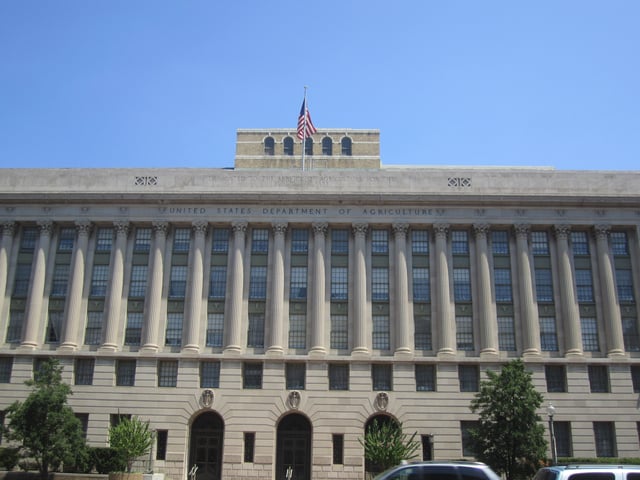United States Department of Agriculture

United States Department of Agriculture

 Logo of the U.S. Department of Agriculture | |
Flag of the U.S. Department of Agriculture | |
| Agency overview | |
|---|---|
| Formed | May 15, 1862 (1862-05-15) Cabinet status: February 15, 1889 |
| Preceding agency |
|
| Jurisdiction | U.S. federal government |
| Headquarters | Jamie L. Whitten Building 1301 Independence Avenue, S.W., Washington, D.C. 38°53′17″N 77°1′48″W [58] |
| Employees | 105,778 (June 2007) |
| Annual budget | US$151 billion (2017)[1] |
| Agency executives |
|
| Website | USDA.gov [59] |
The United States Department of Agriculture (USDA), also known as the Agriculture Department, is the U.S. federal executive department responsible for developing and executing federal laws related to farming, forestry, and food. It aims to meet the needs of farmers and ranchers, promote agricultural trade and production, work to assure food safety, protect natural resources, foster rural communities and end hunger in the United States and internationally.
Approximately 80% of the USDA's $141 billion budget goes to the Food and Nutrition Service (FNS) program. The largest component of the FNS budget is the Supplemental Nutrition Assistance Program (formerly known as the Food Stamp program), which is the cornerstone of USDA's nutrition assistance.[2]
The current Secretary of Agriculture is Sonny Perdue.[3]
 Logo of the U.S. Department of Agriculture | |
Flag of the U.S. Department of Agriculture | |
| Agency overview | |
|---|---|
| Formed | May 15, 1862 (1862-05-15) Cabinet status: February 15, 1889 |
| Preceding agency |
|
| Jurisdiction | U.S. federal government |
| Headquarters | Jamie L. Whitten Building 1301 Independence Avenue, S.W., Washington, D.C. 38°53′17″N 77°1′48″W [58] |
| Employees | 105,778 (June 2007) |
| Annual budget | US$151 billion (2017)[1] |
| Agency executives |
|
| Website | USDA.gov [59] |
Overview
Many of the programs concerned with the distribution of food and nutrition to people of America and providing nourishment as well as nutrition education to those in need are run and operated under the USDA Food and Nutrition Service. Activities in this program include the Supplemental Nutrition Assistance Program, which provides healthy food to over 40 million low-income and homeless people each month.[4] USDA is a member of the United States Interagency Council on Homelessness,[5] where it is committed to working with other agencies to ensure these mainstream benefits have been accessed by those experiencing homelessness.
The USDA also is concerned with assisting farmers and food producers with the sale of crops and food on both the domestic and world markets. It plays a role in overseas aid programs by providing surplus foods to developing countries. This aid can go through USAID, foreign governments, international bodies such as World Food Program, or approved nonprofits. The Agricultural Act of 1949, section 416 (b) and Agricultural Trade Development and Assistance Act of 1954, also known as Food for Peace, provides the legal basis of such actions. The USDA is a partner of the World Cocoa Foundation.
History
Origins
Early in its history, the economy of the United States was largely agrarian. Officials in the federal government had long sought new and improved varieties of seeds, plants and animals for import into the United States. In 1837 Henry Leavitt Ellsworth, a Yale-educated attorney interested in improving agriculture, became Commissioner of Patents, a position within the Department of State. He began collecting and distributing new varieties of seeds and plants through members of the Congress and agricultural societies. In 1839, Congress established the Agricultural Division within the Patent Office and allotted $1,000 for "the collection of agricultural statistics and other agricultural purposes."[6] Ellsworth's interest in aiding agriculture was evident in his annual reports that called for a public depository to preserve and distribute the new seeds and plants, a clerk to collect agricultural statistics, statewide reports about crops in different regions, and the application of chemistry to agriculture. Ellsworth was called the "Father of the Department of Agriculture."
In 1849, the Patent Office was transferred to the newly created Department of the Interior. In the ensuing years, agitation for a separate bureau of agriculture within the department or a separate department devoted to agriculture kept recurring.
Formation and subsequent history

The first Department of Agriculture Building on the National Mall around 1895

The Jamie L. Whitten Building in Washington D.C. is the USDA headquarters.
On May 15, 1862, Abraham Lincoln established the independent Department of Agriculture to be headed by a commissioner without Cabinet status, and the agriculturalist Isaac Newton was appointed to be the first such commissioner.[7] Lincoln called it the "people's department."
In 1868, the Department moved into the new Department of Agriculture Building in Washington, D.C. designed by famed DC architect Adolf Cluss. Located on Reservation No.2 on the National Mall between 12th Street and 14th SW, the Department had offices for its staff and the entire width of the Mall up to B Street NW to plant and experiment with plants.[8]
In the 1880s, varied advocacy groups were lobbying for Cabinet representation. Business interests sought a Department of Commerce and Industry, and farmers tried to raise the Department of Agriculture to Cabinet rank. In 1887, the House of Representatives and Senate passed bills giving Cabinet status to the Department of Agriculture and Labor, but the bill was defeated in conference committee after farm interests objected to the addition of labor. Finally, on February 9, 1889, President Grover Cleveland signed a bill into law elevating the Department of Agriculture to Cabinet level.[9]
In 1887, the Hatch Act provided for the federal funding of agricultural experiment stations in each state. The Smith-Lever Act of 1914 then funded cooperative extension services in each state to teach agriculture, home economics, and other subjects to the public. With these and similar provisions, the USDA reached out to every county of every state.
During the Great Depression, farming remained a common way of life for millions of Americans. The Department of Agriculture's Bureau of Home Economics, established in 1923, published shopping advice and recipes to stretch family budgets and make food go farther.[10] USDA helped ensure that food continued to be produced and distributed to those who needed it, assisted with loans for small landowners, and contributed to the education of the rural youth.
It was revealed on August 27, 2018 that the U.S. Department of Agriculture would be providing U.S. farmers with a farm aid package, which will total $4.7 billion in direct payments to American farmers. This package is meant to offset the losses farmers are expected to incur from retaliatory tariffs placed on American exports during the Trump tariffs.[11]
Organization, budget and tasks

A nutrition researcher considers canned peas
The Department of Agriculture was authorized a budget for Fiscal Year 2015 of $139.7 billion. The budget authorization is broken down as follows:[1]
| Program | Funding (in billions) | |
|---|---|---|
| Management and Finance Secretary of Agriculture | Deputy Secretary of Agriculture | |
| Departmental Administration | 0.3 | |
| Office of the Chief Information Officer | ||
| Office of the Chief Economist | ||
| National Appeals Division | ||
| Office of Small and Disadvantaged Business Utilization | ||
| Office of Communications | ||
| Office of the Inspector General | 0.1 | |
| Office of Tribal Relations | ||
| Office of the General Counsel | ||
| Office of the Chief Financial Officer | ||
| Office of Budget and Program Analysis | ||
| Office of Congressional Relations | ||
| Office of the Assistant Secretary for Civil Rights | ||
| Farm and Foreign Agricultural Services Under Secretary for Farm and Foreign Agricultural Services | Farm Service Agency
| 6.2 |
Risk Management Agency
| 8.7 | |
| Foreign Agricultural Service | 1.8 | |
| Rural DevelopmentUnder Secretary for Rural Development | Rural Business-Cooperative Service | 1.3 |
| Rural Utilities Service | 7.3 | |
| Rural Housing Service | 28.4 | |
| Food, Nutrition, and Consumer Services Under Secretary for Food, Nutrition, and Consumer Services | Food and Nutrition Service | 112.2 |
| Center for Nutrition Policy and Promotion | ||
| Food Safety Under Secretary for Food Safety | Food Safety and Inspection Service | 1.0 |
| Natural Resources and Environment Under Secretary for Natural Resources and Environment | Natural Resources Conservation Service | 4.2 |
| United States Forest Service | 4.8 | |
| Marketing and Regulatory Programs Under Secretary for Marketing and Regulatory Programs | Animal and Plant Health Inspection Service | 1.1 |
| Agricultural Marketing Service | 1.3 | |
| Grain Inspection, Packers and Stockyards Administration | 0.04 | |
| Research, Education, and Economics Under Secretary for Research, Education, and Economics | Agricultural Research Service | 1.1 |
| National Institute of Food and Agriculture | 1.5 | |
| Economic Research Service | 0.1 | |
| National Agricultural Statistics Service | 0.2 | |
| National Agricultural Library | ||
| Under Secretary of Agriculture for Trade and Foreign Agricultural Affairs[12] | ||
| Total | 139.7 | |
Inactive
Agricultural Stabilization and Conservation Service (ASCS) (became part of the Farm Service Agency in 1994)
Animal Damage Control (renamed Wildlife Services)
Soil Conservation Service (SCS) renamed Natural Resources Conservation Service
Section of Vegetable Pathology, Division of Botany (1887–90)[13] Renamed Division of Vegetable Pathology (1890–95)[13]
In 2015, Secretary of Agriculture Tom Vilsack expressed the desire to resign to President Obama. The Washington Post reports that he said "There are days when I have literally nothing to do," he recalled thinking as he weighed his decision to quit."[14] President Obama did not accept his resignation but assigned him additional tasks of combating opioid addiction, a task usually not assigned to the Department of Agriculture.[14]
Discrimination
Allegations have been made that throughout the agency's history its personnel have discriminated against farmers of various backgrounds, denying them loans and access to other programs well into the 1990s.[15] The effect of this discrimination has been the reduction in the number of African-American farmers in the United States.[16] Many black farmers across the nation experienced discrimination in their dealings with in-state USDA agencies. Across the nation, black farmers alleged, and the USDA later agreed, they were denied access to loans and subsidies provided by the government.[17] On a national level, farm subsidies that were afforded to white farmers were not afforded to black farmers.[18] Since they were denied government loans, emergency or disaster assistance, and other aid, many black farmers lost their farms and homes.[19]
In 1999, the USDA settled a class action lawsuit, the Pigford Case, alleging discrimination against African-American farmers in the late twentieth century. The government's settlement of nearly $1 billion with more than 13,300 farmers was reportedly the largest civil rights claim to date.[20] The 2008 Farm Bill provided for additional farmers to have their claims heard, as 70,000 had filed late in the original program.[20] In 2010 the federal government made another $1.2 billion settlement in what is called Pigford II for outstanding claims.[21]
Pigford v. Glickman
Following long-standing concerns, black farmers joined a class action discrimination suit against the USDA filed in federal court in 1997.[21] An attorney called it "the most organized, largest civil rights case in the history of the country."[22] Also in 1997, black farmers from at least five states held protests in front of the USDA headquarters in Washington, D.C.[23] Protests in front of the USDA were a strategy employed in later years as the black farmers sought to keep national attention focused on the plight of the black farmers. Representatives of the National Black Farmers Association met with President Bill Clinton and other administration officials at the White House. And NBFA's president testified before the United States House Committee on Agriculture.[24]
In Pigford v. Glickman, U.S. Federal District Court Judge Paul L. Friedman approved the settlement and consent decree on April 14, 1999.[21] The settlement recognized discrimination against 22,363 black farmers but the NBFA would later call the agreement incomplete because more than 70,000 were excluded.[25] Nevertheless, the settlement was deemed to be the largest-ever civil rights class action settlement in American history. Lawyers estimated the value of the settlement to be more than $2 billion.[17] Some farmers would have their debts forgiven.[26] Judge Friedman appointed a monitor to oversee the settlement.[17] Farmers in Alabama, Mississippi, Arkansas, and Georgia were among those affected by the settlement.[27]
The NBFA's president was invited to testify before congress on this matter numerous times following the settlement including before the United States Senate Committee on Agriculture on September 12, 2000, when he testified that many farmers had not yet received payments and others were left out of the settlement. It was later revealed that one DoJ staff "general attorney" was unlicensed while she was handling black farmers' cases.[28] NBFA called for all those cases to be reheard. The Chicago Tribune reported in 2004 that the result of such longstanding USDA discrimination was that black farmers had been forced out of business at a rate three times faster than white farmers. In 1920, 1 in 7 U.S. farmers was African-American, and by 2004 the number is 1 in 100. USDA spokesman Ed Loyd, when acknowledging that the USDA loan process was unfair to minority farmers, had claimed it was hard to determine the effect on such farmers.[29]
In 2006 the Government Accountability Office (GAO) issued a report highly critical of the USDA in its handling of the black farmers cases.[30] NBFA continued to lobby Congress to provide relief. NBFA's Boyd secured congressional support for legislation that would provide $100 million in funds to settle late-filer cases. In 2006 a bill was introduced into the House of Representatives and later the Senate by Senator George Felix Allen.[31] In 2007 Boyd testified before the United States House Committee on the Judiciary about this legislation. As the organization was making headway by gathering Congressional supporters in 2007 it was revealed that some USDA Farm Services Agency employees were engaged in activities aimed at blocking Congressional legislation that would aid the black farmers.[32] President Barack Obama, then a U.S. Senator, lent his support to the black farmers' issues in 2007.[33] A bill cosponsored by Obama passed the Senate in 2007.[34]
In early June 2008 hundreds of black farmers, denied a chance to have their cases heard in the Pigford settlement, filed a new lawsuit against USDA.[35] The Senate and House versions of the black farmers bill, reopening black farmers discrimination cases, became law in June 2008.[19] Some news reports said that the new law could affect up to 74,000 black farmers.[36] In October 2008, the GAO issued a report criticizing the USDA's handling of discrimination complaints.[37] The GAO recommended an oversight review board to examine civil rights complaints.[38]
After numerous public rallies and an intensive NBFA member lobbying effort, Congress approved and Obama signed into law in December 2010 legislation that set aside $1.15 billion to resolve the outstanding black farmers cases.[39] NBFA's John W. Boyd, Jr., attended the bill-signing ceremony at the White House. As of 2013, 90,000 African-American, Hispanic, female and Native American farmers had filed claims. It was reported that some had been found fraudulent, or transparently bogus. In Maple Hill, North Carolina by 2013, the number of successful claimants was four times the number of farms with 1 out of 9 African-Americans being paid, while "claimants were not required [by the USDA] to present documentary evidence that they had been unfairly treated or had even tried to farm." Lack of documentation is an issue complicated by the USDA practice of discarding denied applications after three years.[40]
Related legislation
Important legislation setting policy of the USDA includes the:
1890, 1891, 1897, 1906 Meat Inspection Act
1906: Pure Food and Drug Act
1914: Cotton Futures Act
1916: Federal Farm Loan Act
1917: Food Control and Production Acts
1921: Packers and Stockyards Act
1922: Grain Futures Act
1922: National Agricultural Conference
1923: Agricultural Credits Act
1930: Perishable Agricultural Commodities Act
1930: Foreign Agricultural Service Act
1933: Agricultural Adjustment Act (AAA)
1933: Farm Credit Act
1935: Resettlement Administration
1936: Soil Conservation and Domestic Allotment Act
1937: Agricultural Marketing Agreement Act
1941: National Victory Garden Program
1941: Steagall Amendment
1946: Farmers Home Administration
1946: National School Lunch Act PL 79-396
1946: Research and Marketing Act
1947: Federal Insecticide, Fungicide, and Rodenticide Act PL 80-104
1948: Hope-Aiken Agriculture Act PL 80-897
1949: Agricultural Act PL 81-439 (Section 416 (b))
1954: Food for Peace Act PL 83-480
1954: Agricultural Act PL 83-690
1956: Soil Bank Program authorized
1956: Mutual Security Act PL 84-726
1957: Poultry Products Inspection Act PL 85-172
1958: Food Additives Amendment PL 85-929
1958: Humane Slaughter Act
1958: Agricultural Act PL 85-835
1961: Consolidated Farm and Rural Development Act PL 87-128
1964: Agricultural Act PL 88-297
1964: Food Stamp Act PL 88-525
1964: Federal Insecticide, Fungicide, and Rodenticide Act Extension PL 88-305
1965: Appalachian Regional Development Act
1965: Food and Agriculture Act PL 89-321
1966: Child Nutrition Act PL 89-642
1967: Wholesome Meat Act PL 90-201
1968: Wholesome Poultry Products Act PL 90-492
1970: Agricultural Act PL 91-524
1972: Federal Environmental Pesticide Control Act PL 92-516
1970: Environmental Quality Improvement Act
1970: Food Stamp Act PL 91-671
1972: Rural Development Act
1972: Rural Development Act Reform 3.31
1972: National School Lunch Act Amendments (Special Supplemental Nutrition Program for Women, Infants and Children) PL 92-433
1973: Agriculture and Consumer Protection Act PL 93-86
1974: Safe Drinking Water Act PL 93-523
1977: Food and Agriculture Act PL 95-113
1985: Food Security Act PL 99-198
1990: Food, Agriculture, Conservation, and Trade Act of 1990 PL 101-624 (This act includes the Organic Foods Production Act of 1990)
1996: Federal Agriculture Improvement and Reform Act PL 104-127
1996: Food Quality Protection Act PL 104-170
2000: Agriculture Risk Protection Act PL 106-224
2002: Farm Security and Rural Investment Act PL 107-171
2008: Food, Conservation, and Energy Act of 2008 PL 110-246
2010: Healthy, Hunger-Free Kids Act of 2010 PL 111-296
Criticism
In 2016, Food & Water Watch claimed that "when independent, government scientists produce research that threatens corporate agribusinesses, the USDA—according to at least 10 government scientists—censors the results, waters down the findings and punishes the researchers".[41]
See also
Adjusted Gross Revenue Insurance
Alternative Agricultural Research and Commercialization Corporation
Dairy Termination Program
Learning agenda
Title 7 of the Code of Federal Regulations
Title 9 of the Code of Federal Regulations
Migratory Bird Treaty Act
National Transportation Safety Board
United States Agricultural Society
US Fish and Wildlife Service
USDA home loan
The Wildlife Society




